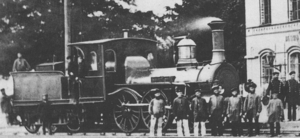Mecklenburg II
| Mecklenburg II | |||
|---|---|---|---|
| Numbering: | 43, 44, 47-53 1895: 2, 6-8 |
||
| Number: | 5 | 1 | 3 |
| Manufacturer: | Borsig | ||
| Year of construction (s): | 1849-1851 | 1851 | 1853 + 1856 |
| Retirement: | 1894-1901 | 1896 | 1891 + 1893 |
| Axis formula : | 1B n2 | ||
| Gauge : | 1435 mm | ||
| Length over buffers: | ≈ 12,095 mm | ||
| Height: | ≈ 4422 mm | ||
| Total wheelbase: | ≈ 3725 mm | ||
| Empty mass: | 22.80 t | 24.00 t | 24.20 t |
| Service mass: | 25.05 t | 26.75 t | 26.60 t |
| Friction mass: | 15.60 t | 21.95 t | 21.20 t |
| Wheel set mass : | 7.80 t | 10.98 t | 10.60 t |
| Coupling wheel diameter: | 1535-1600 mm | ||
| Impeller diameter: | 1015-1045 mm | ||
| Control type : | Stephenson | ||
| Number of cylinders: | 2 | ||
| Cylinder diameter: | 330 mm 356 mm |
380 mm | 381 mm |
| Piston stroke: | 508 mm 559 mm |
559 mm | 559 mm |
| Boiler overpressure: | 8.19 bar 7.31 bar |
7.31 bar | 5.85 bar |
| Number of heating pipes: | 135-143 | 145 | 139 |
| Heating pipe length: | 2794-3058 mm | 4077 mm | 4193 mm |
| Grate area: | 1.07-1.15 m² | 1.07 m² | 0.99 m² |
| Radiant heating surface: | 5.15-5.93 m² | 5.57 m² | 5.16 m² |
| Tubular heating surface: | 48.72-53.51 m² | 80.58 m² | 76.90 m² |
| Evaporation heating surface: | 53.87-58.87 m² | 86.15 m² | 82.06 m² |
| Locomotive brake: | Spindle brake | ||
In the class II which ordered Grand Duchy of Mecklenburg Friedrich-Franz Railway various 1849-1856 procured steam locomotives of the type 1B one. These included five locomotives originally supplied with the 1A1 wheel arrangement.
history
Between 1849 and 1851, Borsig delivered five locomotives with the 1A1 wheel arrangement to the Mecklenburgische Eisenbahngesellschaft , but they differed from the locomotives of the later type I delivered at the same time . The locomotives BERLIN , BÜTZOW , WARNOW , MAGDEBURG and STRELITZ were given the operating numbers 7, 8, 11, 12 and 15. Soon after they were put into operation, it turned out that the locomotives were hauling freight trains between Schwerin and Rostock to the border of the Efficiency got. With a friction mass of 12 t, the locomotives were not suitable for such a purpose. Therefore, from 1851 onwards, Borsig supplied four locomotives with the 1B wheel arrangement. The HERCULES , OBOTRIT , SWANTEWIT and RADEGAST locomotives were given the numbers 16, 18, 19 and 21. With the nationalization in 1873, the RADEGAST was renamed to KIEL , as a class VIII locomotive of the state Friedrich-Franz-Bahn already bore this name. In 1895 BÜTZOW , WARNOW , STRELITZ and HERCULES were given the numbers 2, 6, 7 and 8. The KIEL was the first locomotive to be retired in 1891 . The STRELITZ was the last locomotive of the class to be in service until 1903 .
The five locomotives with the 1A1 wheel arrangement were later converted to 1B.
The locomotives were used on the Schwerin – Rostock and Bützow – Güstrow routes .
Constructive features
The locomotives had an internal fork frame. The three-section long boiler had a steam dome on the middle section of the boiler. The standing kettle had a raised fiery canopy and a safety valve.
The two-cylinder wet steam engine was external. The cylinders were arranged horizontally and the coupling rod worked on the first axis. Like the Stephenson controls, the valve boxes were on the inside.
The coupling axles were suspended on the frame by means of leaf springs below. Balance levers between the springs were used to balance the weight. The front wheels were cushioned by overhead leaf springs on the frame.
The screw brake was on the tender. The locomotives had a spacious driver's cab with side windows.
The locomotives were used with the 2 T 4.45 and 3 T 7.90 tenders.
literature
- Hans-Joachim Kirsche, Hermann Lohr, Georg Thielmann: Lokomotiv-Archiv Mecklenburg / Oldenburg . transpress, Berlin 1989, ISBN 3-344-00326-7 .
